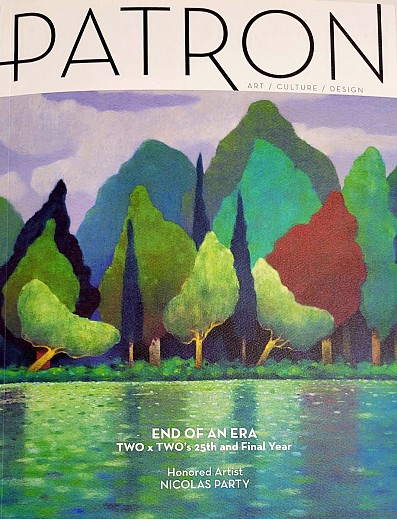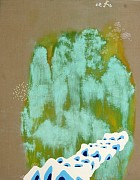


ARTICLE: A Silver Sun Sets
October 1, 2024 - Danielle Avram for PATRON Magazine
A Silver Sun Sets - A Product of Time: 25 Years of TWO x TWO for AIDS and Art culminates the Dallas Museum of Art’s quarter-century acquisition journey through the exalted fundraiser.
A 25th anniversary is typically celebrated with silver. It’s fitting then that The Warehouse’s latest exhibition, A Product of Time: 25 Years of TWO x TWO for AIDS and Art, opens with an explosion of silver in the form of David Altmejd’s large-scale sculpture, The Eye. Capturing the force of an atomic blast, the structure appears to simultaneously collapse inward and expand outward, cracking and shattering under the pressure. A dizzying array of mirrored staircases, obelisks, and rods pierce the surface of a mirrored base.
An explosion is an apt metaphor for TWO x TWO, the art auction that has forever altered the contemporary art landscape of Dallas and beyond. Started in 1999 by famed art collectors Cindy and Howard Rachofsky, TWO x TWO has somewhat humble origins for an event of its magnitude. The couple, longtime supporters of the Dallas Museum of Art, had completed their 10,000-square-foot, Richard Meier–designed home in Preston Hollow in 1996 and were looking for a more purposeful use for their home beyond simply entertaining guests. Enter close friend and fellow Dallas-based art collector Deedie Rose, who had an existing connection to the nonprofit amfAR, the Foundation for AIDS Research. The organization had previously held a fundraiser in Dallas and was looking to strengthen its relationship with the city.
Approximately six weeks later, the first TWO x TWO auction was held, raising a significant sum to be split evenly between the DMA and amfAR. The event was repeated the following year, in 2000, with actress Sharon Stone serving as auctioneer and emcee, and artist Robert Rauschenberg awarded the first annual amfAR Award of Excellence for Artistic Contributions to the Fight Against AIDS. Following its repeat success, TWO x TWO clearly had the momentum to keep growing. “We never in a million years imagined we’d be doing this for two and a half decades after the beginning, nor did we imagine we were going to be raising the kinds of dollars we’ve been able to raise,” Howard Rachofsky explains. “I would have to give Cindy all the credit for making this the art event to go to in Dallas; her mandate early on was if we’re going to keep doing this thing it’s going to have to be an extraordinary event.”
But all good things must come to an end, and so this October will mark the final iteration of TWO x TWO, which has, to date, raised a total of $120 million for amfAR and the DMA, and added 350 works of contemporary art to the museum’s permanent collection. To celebrate the occasion, the Rachofskys’ private exhibition space, The Warehouse, is hosting A Product of Time: 25 Years of TWO x TWO for AIDS and Art, culled from the museum’s collection of pieces purchased with TWO x TWO funds.
Curated by the DMA’s contemporary curatorial roster of Anna Katherine Brodbeck, Hoffman Family Senior Curator of Contemporary Art; Vivian Li, Lupe Murchison Curator of Contemporary Art; and Ade Omotosho, Nancy and Tim Hanley Assistant Curator of Contemporary Art, the exhibition showcases the breadth of works—including strong holdings of postwar German art and Japanese Gutai—that the museum has been able to collect with auction earnings. It’s an opportunity not afforded to many museum curators, who are often hamstrung by the mechanics of wooing potential donors to generate funds, many of which are attached to short purse strings.
“TWO x TWO has provided the curators resources to come up with interesting ideas,” says Rachofsky. “Most museums don’t have deep pockets, and TWO x TWO has given these curators the opportunity to be imaginative and creative and to know that if they see something at a fair or a gallery that would be beneficial to the collection, they can acquire it. They can focus on the art and not on the finances.”
A Product of Time developed organically, with Brodbeck, Li, and Omotosho each identifying works of interest that gave way to natural groupings according to process and subject matter. Each section also includes the work of an artist who has had a solo exhibition at the DMA, emphasizing the role TWO x TWO has played in turning the museum into a driving force for the creation and collection of contemporary art.
“Seeing A Product of Time is a remarkable experience for all of us, whether you have been part of TWO x TWO for the long haul, or if you are a new viewer of contemporary art,” says TWO x TWO executive director Melissa Ireland. “The impact of TWO x TWO has been profound, undoubtedly, but to see in person this collection of works that were thoughtfully assembled over a 25-year period is a wonderfully tangible reminder that through philanthropy and goodwill we have the opportunity for real agency, not just to inspire, but to facilitate growth and even transform institutions.”
As with any permanent collection, the works accessioned with these funds are reflective of art world trends, significant moments and artists, and the interests of the various curatorial teams over the past 25 years, but also the museum’s increasing focus on telling lesser-known contemporary art narratives. For example, Omotosho cites the fund as being crucial to the museum’s holding of significant works by Black abstractionists like Frank Bowling and Ed Clark, both of whom have paintings in the show. “Much of the work of a museum is to tell this kind of march through history using the objects you have in the collection,” he explains, “but it’s very hard to have an inclusive display if you’re missing key works by Black artists who were active at the same time as others. TWO x TWO has allowed us to tell a more robust story of the history of art.”
A Product of Time: 25 Years of TWO x TWO for AIDS and Art culminates the Dallas Museum of Art’s quarter-century acquisition journey through the exalted fundraiser.
25th anniversary is typically celebrated with silver. It’s fitting then that The Warehouse’s latest exhibition, A Product of Time: 25 Years of TWO x TWO for AIDS and Art, opens with an explosion of silver in the form of David Altmejd’s large-scale sculpture, The Eye. Capturing the force of an atomic blast, the structure appears to simultaneously collapse inward and expand outward, cracking and shattering under the pressure. A dizzying array of mirrored staircases, obelisks, and rods pierce the surface of a mirrored base.
An explosion is an apt metaphor for TWO x TWO, the art auction that has forever altered the contemporary art landscape of Dallas and beyond. Started in 1999 by famed art collectors Cindy and Howard Rachofsky, TWO x TWO has somewhat humble origins for an event of its magnitude. The couple, longtime supporters of the Dallas Museum of Art, had completed their 10,000-square-foot, Richard Meier–designed home in Preston Hollow in 1996 and were looking for a more purposeful use for their home beyond simply entertaining guests. Enter close friend and fellow Dallas-based art collector Deedie Rose, who had an existing connection to the nonprofit amfAR, the Foundation for AIDS Research. The organization had previously held a fundraiser in Dallas and was looking to strengthen its relationship with the city.
States Li, “That’s the great thing about a permanent collection. It’s built by many people, many interests, new research, new scholarship. It evolves, and it’s always changing. Twenty-five years is a long time!” This sentiment is echoed by the exhibition’s pairingof Shozo Shimamoto’s poured-enamel painting and Lynda Benglis’s poured-latex floor piece, both of which were made close to the same time but in very different contexts. Says Li, “The artists had different intentions, but the works dialogue so well. We sometimes joke that if we had to save only one work from a fire, it must be the Shimomoto. It’s a standout in any collection.”
Another goal of the exhibition was to showcase objects, like Altmejd’s sculpture, that are delicate, labor-intensive, or require a significant amount of technology—all of which the TWO x TWO fund covers in addition to the work itself.
One such piece is Ian Cheng’s BOB (Bag of Beliefs), which was acquired in 2019 and is a personal favorite of Brodbeck’s: “BOB is essentially a piece of AI. He’s a creature who lives in a closed environment that you interact with via an app. BOB has editions in different institutions, so some of us came together to form a ‘network of care’ so we can work collaboratively on maintenance. This piece is a great example of how we’ve been able to acquire works that we otherwise wouldn’t have been able to add to the collection. TWO x TWO has allowed us to have an ambitious collecting program.”
Adds Li, “There is a distinct ‘before and after’ TWO x TWO in the contemporary collection. It transformed the collection into something very formidable.”
Without TWO x TWO, it remains to be seen how the DMA will continue its collecting strategy, but all three curators and Rachofsky are positive about the future of the museum and the city’s role as a contemporary arts destination.
Remarks Rachfosky, “It’s a bittersweet moment, but this is it. It’s time to move on. TWO x TWO helped break down the barrier for enjoying contemporary art, and now there are many talented and bright younger people who can find a way. It’s time for them to embark on their own adventures.” P
Download Article (PDF)Back to News
